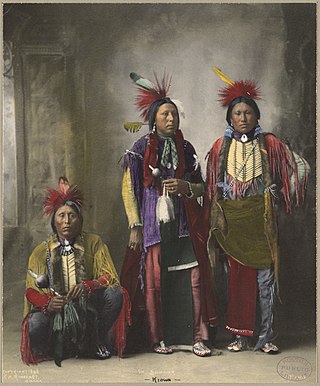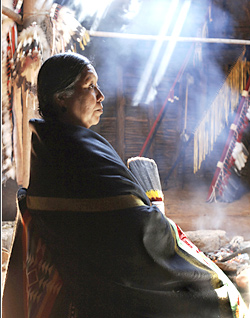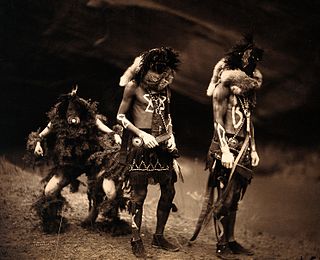
Kiowa or CáuigúIPA:[kɔ́j-gʷú]) people are a Native American tribe and an Indigenous people of the Great Plains of the United States. They migrated southward from western Montana into the Rocky Mountains in Colorado in the 17th and 18th centuries, and eventually into the Southern Plains by the early 19th century. In 1867, the Kiowa were moved to a reservation in southwestern Oklahoma.
The Apache are several Southern Athabaskan language–speaking peoples of the Southwest, the Southern Plains and Northern Mexico. They are linguistically related to the Navajo. They migrated from the Athabascan homelands in the north into the Southwest between 1000 and 1500 CE.
Lipan Apache are a band of Apache, a Southern Athabaskan Indigenous people, who have lived in the Southwest and Southern Plains for centuries. At the time of European and African contact, they lived in New Mexico, Colorado, Oklahoma, Texas, and northern Mexico. Historically, they were the easternmost band of Apache.

Mescalero or Mescalero Apache is an Apache tribe of Southern Athabaskan–speaking Native Americans. The tribe is federally recognized as the Mescalero Apache Tribe of the Mescalero Apache Reservation, located in south-central New Mexico.

Jicarilla Apache, one of several loosely organized autonomous bands of the Eastern Apache, refers to the members of the Jicarilla Apache Nation currently living in New Mexico and speaking a Southern Athabaskan language. The term jicarilla comes from Mexican Spanish meaning "little basket", referring to the small sealed baskets they used as drinking vessels. To neighboring Apache bands, such as the Mescalero and Lipan, they were known as Kinya-Inde.

The Plains Apache are a small Southern Athabaskan tribe who live on the Southern Plains of North America, in close association with the linguistically unrelated Kiowa Tribe. Today, they are headquartered in Southwestern Oklahoma and are federally recognized as the Apache Tribe of Oklahoma. They mostly live in Comanche and Caddo County, Oklahoma.

The Tonkawa are a Native American tribe who now live in Oklahoma. Their Tonkawa language, now extinct, is a linguistic isolate.
State-recognized tribes in the United States are organizations that identify as Native American tribes or heritage groups that do not meet the criteria for federally recognized Indian tribes but have been recognized by a process established under assorted state government laws for varying purposes or by governor's executive orders. State recognition does not dictate whether or not they are recognized as Native American tribes by continually existing tribal nations.

The San Carlos Apache Indian Reservation, in southeastern Arizona, United States, was established in 1872 as a reservation for the Chiricahua Apache tribe as well as surrounding Yavapai and Apache bands removed from their original homelands under a strategy devised by General George Crook of setting the various Apache tribes against one another. Once nicknamed "Hell's Forty Acres" during the late 19th century due to poor health and environmental conditions, modern San Carlos Apaches operate a Chamber of Commerce, the Apache Gold and Apache Sky Casinos, a Language Preservation program, a Culture Center, and a Tribal College.

In the United States, the eagle feather law provides many exceptions to federal wildlife laws regarding eagles and other migratory birds to enable Native Americans to continue their traditional, spiritual and cultural practices.

The American Indian Religious Freedom Act, Public Law No. 95–341, 92 Stat. 469, codified at 42 U.S.C. § 1996, is a United States federal law, enacted by joint resolution of the Congress in 1978. Prior to the act, many aspects of Native American religions and sacred ceremonies had been prohibited by law.

Native American religions are the spiritual practices of the Native Americans in the United States and the Indigenous peoples in Canada. Ceremonial ways can vary widely and are based on the differing histories and beliefs of individual nations, tribes and bands. Early European explorers describe individual Native American tribes and even small bands as each having their own religious practices. Theology may be monotheistic, polytheistic, henotheistic, animistic, shamanistic, pantheistic or any combination thereof, among others. Traditional beliefs are usually passed down in the forms of oral histories, stories, allegories, and principles.

The Native American Church (NAC), also known as Peyotism and Peyote Religion, is a syncretic Native American religion that teaches a combination of traditional Native American beliefs and elements of Christianity, especially pertaining to the Ten Commandments, with sacramental use of the entheogen peyote. The religion originated in the Oklahoma Territory (1890–1907) in the late nineteenth century, after peyote was introduced to the southern Great Plains from Mexico. Today, it is the most widespread indigenous religion among Native Americans in the United States, Canada, and Mexico, with an estimated 300,000 adherents.
The Lipan Apache Tribe of Texas is a state-recognized tribe and nonprofit organization in Texas. Members of the tribe descend from the Lipan Apache, a Southern Athabaskan Indigenous people. The Lipan Apache Tribe of Texas is headquartered in McAllen, Texas.
New Mexico v. Mescalero Apache Tribe, 462 U.S. 324 (1983), was a case in which the Supreme Court of the United States held that the application of New Mexico's laws to on-reservation hunting and fishing by nonmembers of the Tribe is preempted by the operation of federal law.
The Choctaw-Apache Tribe of Ebarb is a state-recognized tribe and nonprofit organization in Louisiana. The members of the tribe are the descendants of Choctaw and Lipan Apache people and are required to prove lineal descent as part of their state-approved membership process. The tribe is based in the towns of Zwolle, Louisiana and Ebarb, Louisiana, both of which are in Sabine Parish, Louisiana, where the group have lived since the early 18th century.

Darcie Little Badger is an American novelist, short story writer, and Earth scientist.

Native American tribes in Texas are the Native American tribes who are currently based in Texas and the Indigenous peoples of the Americas who historically lived in Texas.

The Lipan Apache Band of Texas is a cultural heritage organization of individuals who identify as descendants of Lipan Apache people The organization LABT is based in Edinburg, Texas; with members living in Texas, Louisiana, California, and Mexico.











